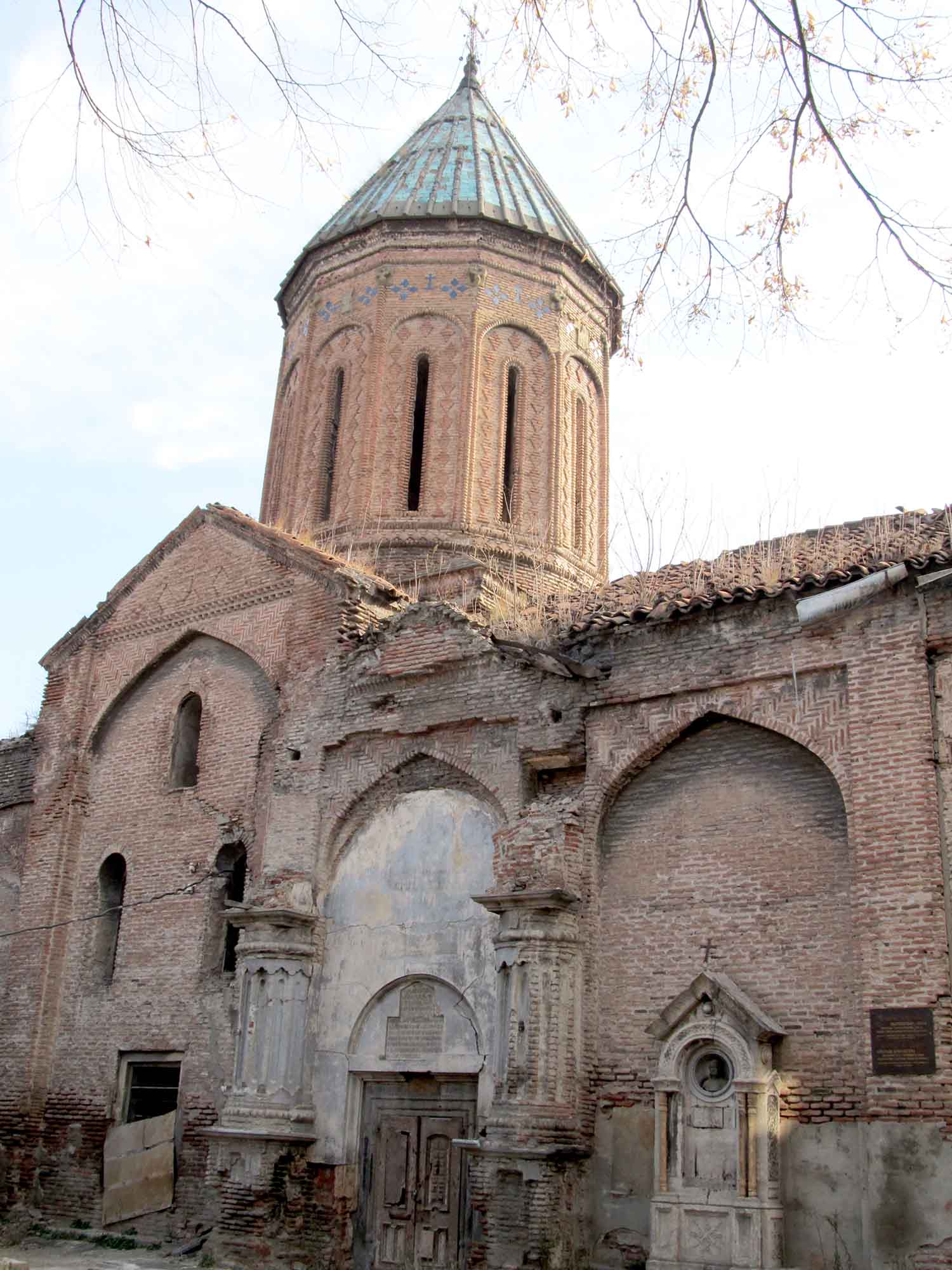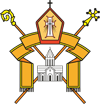SOURB NSHAN (SOURB NIKOGHAYOS) CHURCH
THE CHURCH WAS ESTABLISHED IN 1624. SAINT NSHAN CHURCH WAS HEAVILY DAMAGED BY FIRE INCIDENTS THAT HAPPENED SEVERAL TIMES. THE CHURCH NOW IS STANDING BUT IN STRUCTURALLY UNSTABLE CONDITION.
Establishment and reconstructions: St. Nshan Church in Tbilisi is one of those Armenian cultural monuments, that stands out not only for its traditional Armenian architectural composition but also for its elements of Georgian and Eastern culture. Currently, the issue of church belongingness is a subject of dispute between the Georgian Orthodox and Armenian Apostolic Churches. St. Nshan Church was located in the center of Kalo (Kalos Ubani) district of old Tiflis.
Due to the fact that the preserved construction records and original sources are not fully preserved, it is not possible to specify the exact year of the church's foundation. Thus, according to the records of Armenian manuscripts, the church was founded in 1624[1]. According to the inscription preserved in the northern lintel of the church, it was founded during the years 1703-1720[2]. As of 1720, the church still did not have a dome. Despite this, it has started functioning[3]. The dome was added in 1780[4].
Regarding the question of the foundation and belongingness of the church, the Georgian researchers put forward the point of view according to which Armenians founded the mentioned church in the place of the previously existing Georgian Orthodox church in 1703. This point of view was put forward by the Georgian researcher P. Ioseliani[5]. Later, many authors, including Armenian researchers[6], relied on his opinion. It should be noted that the information provided by P. Ioseliani is not based on multiple sources.
Basically, it can be stated that both Armenian and Georgian researchers agree on the fact that the church existed before 1703. Disagreements revolve around the question of who originally founded the church: Armenians or Georgians.
It is true that St. Nshan church already had a complete architectural appearance in the 19th century, but in this period the church underwent a number of renovations. Particularly, in 1830, on the initiative of churchwarden Avetis Piroyants, illustrations of the interior volumes of the church were implemented. The general improvement of the building was carried out in 1837 [7]. The chapel of the church was built in 1861. Renovation works were also carried out in the 1880s and 1890s.
 Architecture: The architectural description of St. Nshan church was presented by both foreign and Armenian authors. According to the monument expert S. Karapetyan, the church has a domed three-naved basilica design common in Armenian church construction in the 17th-18th centuries.
Architecture: The architectural description of St. Nshan church was presented by both foreign and Armenian authors. According to the monument expert S. Karapetyan, the church has a domed three-naved basilica design common in Armenian church construction in the 17th-18th centuries.
The central dome of the church is dedicated to St. Nicholas (Nikoghayos), and the side ones are dedicated to St. Andrew and George[8], and pair of columns supports the drum and vaults, which feature a design with 12 aisles. Sacristies are double-storeyed. On the second floor, the entrances open into the altar and are connected with it with 17 stairs. The main building material is brick. Stone is also used. Roofs are tiled. The interior volumes were covered with frescoes. The top of the western chancel has a belfry standing on eight columns, and in front of the northern entrance, there is a four-column narthex [9].
Clergy: At different times, among the clergy of St. Nshan church were senior priest Rev. Father Hovhannes Mkrtumyan[10], Grigor Ter-Davtyan Izmiryants[11], Andreas Ter-Stepanyan Ambartanyants[12], Petros Ohanyan Ter-Karapetyants[13], Yesayi. Mehrabyants[14], Grigor Shermazanyants[15].
School: From the first half of the 19th century, male and female schools, as well as a school for candidates for priesthood, were opened adjacent to St. Nshan Church. The male school was opened in 1848[16], and the female school was opened in 1873[17]. The educational institution opened in 1883, which already had 200 students in 1884, was considered the most famous girls' school. The female school of St. Nshan church stood out both for its general organization and the professionalism of its teachers. The school for candidates for the priesthood was opened in 1876 during the leadership of Archbishop Gabriel Aivazovsky (1876-1880). At the moment, 40 candidates for priesthood studied at the school[18].
Cemetery: St. Nshan church also had a cemetery attached to it, which occupied its northern and partly western side. In the 1970s, most of the tombstones in the northern section were paved over. Only a few tombstones remained visible, which could not be paved due to their height. In addition to tombstones, there were also grave statues in the cemetery. Two of them have been preserved: Avetik Piroyan's (1858) and Barsegh Meghvinyan's (1894). The earliest preserved tombstones date back to 1743[19].
Economic condition: St. Nshan church had movable and immovable properties[20], as well as a brick factory, which was built and donated by Melik Georgi and his family.[21] According to the bulletin of church properties in 1875, St. Nshan church also had a small garden[22].
The church in the Soviet period: In 1928, together with a number of churches in Tbilisi, St. Nshan church was sealed and closed. In 1930, the church was returned to the community [23], but on May 3, 1931, it was closed again. During the Soviet years, the church building was adapted and served different purposes. During World War II, the church served as a warehouse for pasta and vermicelli. Later, it was turned into a library of the National Library, and also into a sewing workshop. In the early 1980s, the church was turned into a book depository[24]. St. Nshan church was also heavily damaged by several fire incidents. The first one took place on the night of October 20, 2002. According to official data, the cause of the fire was not known. Fire occurred for the second and third time on January 3 and 7, 2012. We should also add that until the fire in 2002, the church was constantly closed due to being used for different purposes. After the fire, the church building's deterioration escalated significantly. Due to the corrosive effect of water, sediments have formed in the central part of the prayer hall and on the tombstone-covered surface of the northern entrance containing burials. The frescoes of the church have also been almost completely destroyed.
After the independence of Georgia in 1991, not only did the continuous decay of the church deepen year by year, but it also stopped being considered a historical monument, because every day, one after another, residential buildings approved by the authorities began to be built next to the walls of the church. St. Nshan church, always within the ambitions of the Georgian Orthodox Church, faced frequent harassment from its representatives, including those of the Georgian SSR and state structures of Georgia after gaining independence. The church, which was filled with garbage and turned into a shelter for dogs and strays, nevertheless received the status of a historical monument in 2007, partial metal structural strengthening works were carried out, but everything ended with that. The church is standing today but in a dilapidated condition.
[1] Memoirs of Armenian manuscripts of the 17th century, vol. 2, Yerevan, 1978, p. 155:
[2] P. M. Muradyan, Armenian Epigraphy of Georgia, Yerevan, 1988, с. 69:
[3] P. M. Muradyan, in the same place, p. 73:
[4] S. Karapetyan, St. Nshan of Tbilisi, St. Nicholas Church, Yerevan, 2012, p. 1:
[5] P. Iosseliani, Description of the antiquities of Tiflis city, 1866, с. 258.
[6] Gyut Aghanyants writes about St. Nshan Church in his historical references about the construction of Armenian churches in Tiflis: “Traditionally, it is said that the place of St. Nshan church was formerly the Georgian Church of St. Nicholas the Wonderworker and the Armenians capturing built the church of the same name in that spot” (NAA, ֆ. 332, ց. 1, գ. 102, թ. 8).
[7] A. Yeritsyan's archive, paper. 148, doc. 179:
[8] P. M. Muradyan, in the same place, p. 69:
[9] S. Karapetyan, in the same place, p. 20-21:
[10] NAA, ֆ. 53, ց. 1, գ. 457, թ. 14:
[11] NAA, ֆ. 53, in the same place, թ. 14-ի շրջ.:
[12] In the same place
[13] NAA, ֆ. 56, ց. 1, գ. 2914, թ. 124-ի շրջ.:
[14] NAA, ֆ. 53, ց. 1, գ. 491, թ. 216-ի շրջ.- 217:
[15] NAA, ֆ. 53, ց. 1, գ. 491, in the same place:
[16] S. Karapetyan, in the same place, p. 25:
[17] “Meghu Hayastani” weekly newspaper, 1873, N 9, March 10, p. 3:
[18] “Meghu Hayastani” weekly newspaper, 1876, N 40, October 16, p. 3:
[19] In the same place, p. 27:
[20] NAA, ֆ. 56, ց. 6, գ. 39, թ. 61:
[21] P. M. Muradyan, in the same place, p. 73:
[22] NAA, ֆ. 53, ց. 1, գ. 3864, թ. 63 շրջ.-64:
[23] NAA, ֆ. 409, ց. 1, գ. 3254, թ. 39-ի շրջ.:
[24] S. Karapetyan, in the same place, p. 17:
 Հայերեն
Հայերեն  ქართული
ქართული  English
English  Русский
Русский 


